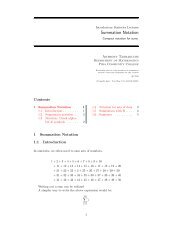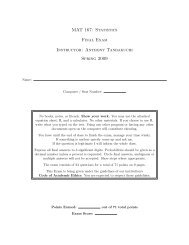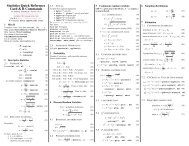MAT 167: Statistics Midterm Exam Instructor: Anthony Tanbakuchi ...
MAT 167: Statistics Midterm Exam Instructor: Anthony Tanbakuchi ...
MAT 167: Statistics Midterm Exam Instructor: Anthony Tanbakuchi ...
Create successful ePaper yourself
Turn your PDF publications into a flip-book with our unique Google optimized e-Paper software.
8 Hypothesis Tests<br />
Test statistic and R function (when available) are listed for each.<br />
Optional arguments for hypothesis tests:<br />
alternative="two.sided" can be:<br />
"two.sided", "less", "greater"<br />
conf.level=0.95 constructs a 95% confidence interval. Standard CI<br />
only when alternative="two.sided".<br />
Optional arguments for power calculations & Type II error:<br />
alternative="two.sided" can be:<br />
"two.sided" or "one.sided"<br />
sig.level=0.05 sets the significance level α.<br />
8.1 1-SAMPLE PROPORTION<br />
H0 : p = p0<br />
prop.test(x, n, p=p0, alternative="two.sided")<br />
ˆp − p0<br />
z = √<br />
p0q0/n<br />
8.2 1-SAMPLE MEAN (σ KNOWN)<br />
H0 : µ = µ0<br />
z =<br />
¯x − µ0<br />
σ/ √ n<br />
8.3 1-SAMPLE MEAN (σ UNKNOWN)<br />
(72)<br />
(73)<br />
H0 : µ = µ0<br />
t.test(x, mu=µ0, alternative="two.sided")<br />
Where x is a vector of sample data.<br />
¯x − µ0<br />
t =<br />
s/ √ n , d f = n − 1 (74)<br />
Required Sample size:<br />
power.t.test(delta=h, sd =σ, sig.level=α, power=1 −<br />
β, type ="one.sample", alternative="two.sided")<br />
8.4 2-SAMPLE PROPORTION TEST<br />
H0 : p1 = p2 or equivalently H0 : ∆p = 0<br />
prop.test(x, n, alternative="two.sided")<br />
where: x=c(x1, x2) and n=c(n1, n2)<br />
∆ ˆp − ∆p0<br />
z = √ , ∆ ˆp = ˆp1 − ˆp2 (75)<br />
¯p ¯q ¯p ¯q<br />
+ n1 n2<br />
x1 + x2<br />
¯p = , ¯q = 1 − ¯p (76)<br />
n1 + n2<br />
Required Sample size:<br />
power.prop.test(p1=p1, p2=p2, power=1 − β,<br />
sig.level=α, alternative="two.sided")<br />
8.5 2-SAMPLE MEAN TEST<br />
H0 : µ1 = µ2 or equivalently H0 : ∆µ = 0<br />
t.test(x1, x2, alternative="two.sided")<br />
where: x1 and x2 are vectors of sample 1 and sample 2 data.<br />
∆ ¯x − ∆µ0<br />
t = √ d f ≈ min(n1 − 1, n2 − 1), ∆ ¯x = ¯x1 − ¯x2 (77)<br />
s 2 1 + s2 2<br />
n1 n2<br />
Required Sample size:<br />
power.t.test(delta=h, sd =σ, sig.level=α, power=1<br />
β, type ="two.sample", alternative="two.sided")<br />
−<br />
8.6 2-SAMPLE <strong>MAT</strong>CHED PAIRS TEST<br />
H0 : µd = 0<br />
t.test(x, y, paired=TRUE, alternative="two.sided")<br />
where: x and y are ordered vectors of sample 1 and sample 2 data.<br />
t = d¯<br />
− µd0<br />
sd/ √ n<br />
, di = xi − yi, d f = n − 1 (78)<br />
Required Sample size:<br />
power.t.test(delta=h, sd =σ, sig.level=α, power=1<br />
β, type ="paired", alternative="two.sided")<br />
8.7 TEST OF HOMOGENEITY, TEST OF INDEPENDENCE<br />
H0 : p1 = p2 = ··· = pn (homogeneity)<br />
H0 : X and Y are independent (independence)<br />
chisq.test(D)<br />
Enter table: D=data.frame(c1, c2, ...), where c1, c2, ... are<br />
column data vectors.<br />
Or generate table: D=table(x1, x2), where x1, x2 are ordered vectors<br />
of raw categorical data.<br />
χ 2 (Oi − Ei)2<br />
= ∑ , d f = (num rows - 1)(num cols - 1) (79)<br />
Ei<br />
(row total)(column total)<br />
Ei = = npi (80)<br />
(grand total)<br />
For 2 × 2 contingency tables, you can use the Fisher Exact Test:<br />
fisher.test(D, alternative="greater")<br />
(must specify alternative as greater)<br />
9 Linear Regression<br />
9.1 LINEAR CORRELATION<br />
H0 : ρ = 0<br />
cor.test(x, y)<br />
where: x and y are ordered vectors.<br />
r =<br />
∑(xi − ¯x)(yi − ȳ)<br />
(n − 1)sxsy<br />
, t = √<br />
r − 0<br />
1−r 2<br />
n−2<br />
−<br />
, d f = n − 2 (81)<br />
9.2 MODELS IN R<br />
MODEL TYPE EQUATION R MODEL<br />
linear 1 indep var y = b0 + b1x1 y∼x1<br />
. . . 0 intercept y = 0 + b1x1 y∼0+x1<br />
linear 2 indep vars y = b0 + b1x1 + b2x2 y∼x1+x2<br />
. . . inteaction y = b0 + b1x1 + b2x2 + b12x1x2 y∼x1+x2+x1*x2<br />
polynomial y = b0 + b1x1 + b2x2 2 y∼x1+I(x2 ∧ 2)<br />
9.3 REGRESSION<br />
Simple linear regression steps:<br />
1. Make sure there is a significant linear correlation.<br />
2. results=lm(y∼x) Linear regression of y on x vectors<br />
3. results View the results<br />
4. plot(x, y); abline(results) Plot regression line on data<br />
5. plot(x, results$residuals) Plot residuals<br />
y = b0 + b1x1 (82)<br />
b1 =<br />
∑(xi − ¯x)(yi − ȳ)<br />
∑(xi − ¯x) 2 (83)<br />
b0 = ȳ − b1 ¯x (84)<br />
9.4 PREDICTION INTERVALS<br />
To predict y when x = 5 and show the 95% prediction interval with regression<br />
model in results:<br />
predict(results, newdata=data.frame(x=5),<br />
int="pred")<br />
10 ANOVA<br />
10.1 ONE WAY ANOVA<br />
1. results=aov(depVarColName∼indepVarColName,<br />
data=tableName) Run ANOVA with data in TableName,<br />
factor data in indepVarColName column, and response data in<br />
depVarColName column.<br />
2. summary(results) Summarize results<br />
3. boxplot(depVarColName∼indepVarColName,<br />
data=tableName) Boxplot of levels for factor<br />
To find required sample size and power see power.anova.test(...)<br />
11 Loading external data<br />
• Export your table as a CSV file (comma seperated file) from Excel.<br />
• Import your table into MyTable in R using:<br />
MyTable=read.csv(file.choose())







